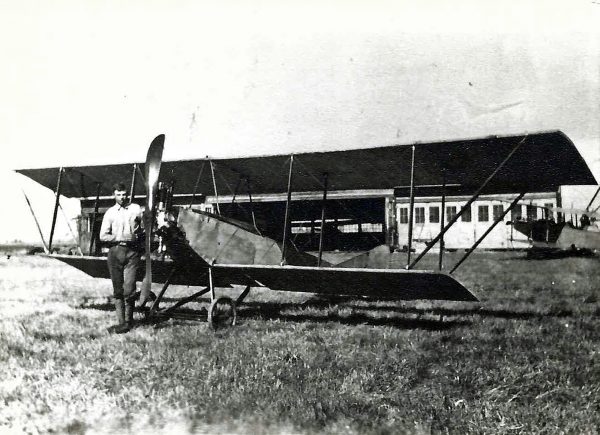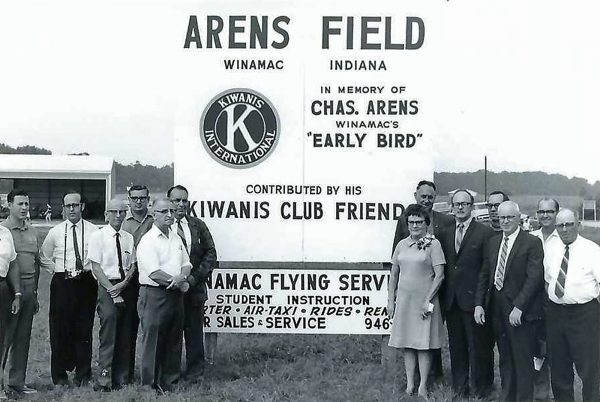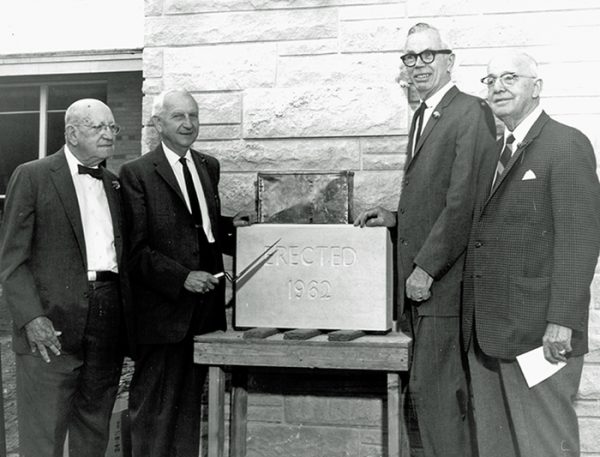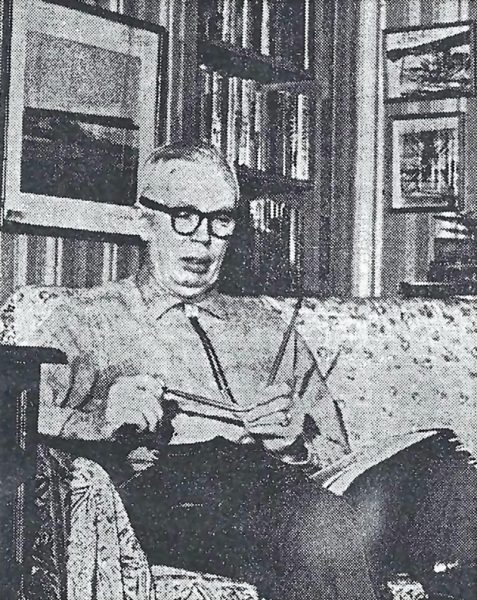By Karen Clem Fritz

Motorists who drive north of Winamac on U.S. 35 likely notice the airport named Arens Field as they pass by. And many may wonder, who was this Arens?
As time has passed, most alive today never knew Charles A. Arens, the friendly, dynamic businessman, inventor and civic leader – who at heart was forever an aviation enthusiast.
This passion blossomed in earnest in the summer of 1915 when, at the age of 19, Charlie (as he was known) began building a biplane in the attic of his home. The following year, he disassembled the fragile aircraft, transported it to Ashburn Field in Chicago where he reassembled it – and took the plane for a documented solo flight. This qualified him for membership in a rarified group known as The Early Birds.

The organization was founded in 1928 by a group of pioneer aviators for the purpose of preserving aviation history, advancing interest in aeronautics and the enjoyment of good fellowship. Membership in the group necessitated documentary evidence of solo flight in heavier- or lighter-than-air craft before Dec. 17, 1916. The Early Birds ultimately accepted a membership of 598 aviators who encompassed the pioneer era of aviation, and the organization dissolved in 1998 when the last member died.
Charles Anthony Arens was born Dec. 17, 1895 in Chicago, a son of Mr. and Mrs. Charles H. Arens. His mother, the former Henrietta Brust, was a native of Winamac, and the Arens family often visited locally during young Charlie’s youth. As a teen, he built model airplanes. In adulthood, he became an inventor and manufacturer of controls for the aircraft industry. He eventually founded his own company, Arens Controls, Inc. in Evanston, Ill. (now re-located to Arlington Heights), plus a second company in Croydon, England. In 1944 he retired as president of the company and moved to Winamac with his wife Helen. For the next 22 years, he became an active civic leader, serving on the Chamber of Commerce, two terms on the Winamac Town Board, and as the first board president of Pulaski Memorial Hospital. Lastly he was an advisor on the development of the city/county airport in Winamac which bears his name, Arens Field.
But it is Arens’ contributions to the aviation industry for which he is most admired and remembered.

Arens was educated in Chicago public schools, and afterward he went to work for the Rock Island Railroad in 1910. A year later, his abiding fascination with airplanes drew him to become a charter member of the Illinois Model Aero Club. He spent much time with other members at the Cicero Field where they flew their model planes and poured over the designs and mechanics of aircraft. Among those he met was Emil Matthew “Matty” Laird, a pioneering American aircraft designer, builder, pilot and businessman. Arens began assisting Laird and other pilots as a mechanic. He soon quit his railroad job and gained a sterling reputation and employment as an aviation mechanic. When Charlie brought his (finally) completed, attic-built biplane to Ashburn Field, it was Laird who was among the first to take it up in flight.
A typewritten Arens family history shares that (at last!) Charlie “with no previous flying instruction or training” got into the plane, “taxied around to get the feel of the machine and then flew it across Ashburn Field.” Decades later, in a 1965 handwritten account of the event, Charlie good-naturedly explained that he “just hopped” the biplane above the air field. Even so, another Early Bird was qualified.

Soon after – on Dec. 20, 1916 – Arens secured employment as an aviation mechanic with the Lowe, Willard & Fowler Engineering Company, a Long Island, NY-based manufacturer of airplanes founded a year earlier. He earned $25 a week – a good wage for the times. After the U.S. entered World War I in 1917, LWF assigned Arens to ride as mechanic-on-board for “test hops” of the planes the company was building for the war effort. Arens reminisced on the experience for an article with the Logansport Pharos-Tribune in 1963, explaining his work was “nearly like riding as a mechanic on a hurricane because it was his duty to climb out on the wings and other parts of the flying craft to check parts and to make repairs,” the article read. “It was fun,” Arens said. “I didn’t think of it as dangerous at the time.”
However, a week after the war ended on Nov. 11, 1918, Arens rode with LWF test pilot Allan Adams, headed to Washington, D.C. from Long Island to demonstrate a plane. But tragedy struck when the aircraft crashed in a heavy fog on a Long Island farm. Adams was killed, and Arens seriously injured. In a 1966 interview, Arens told the Indianapolis Star that after nearly two months in the hospital, the incident led him to decide his place was on the ground in the mechanics shops.

Arens worked for LWF Engineering for seven years, until the company closed in 1923. He returned to Chicago and went to work for his fellow Model Aero Club member’s firm, the E.M. Laird Airplane Co. Three years, later, holding a coveted A&E Mechanic License, No. 240, he became a mechanic for the newly-established Chicago-Minneapolis Air Mail Line.
Throughout these early employment and war-effort experiences, Charlie’s fascination with the mechanical operation of the aircraft led him to design and develop better ways to improve their performance. His early invention of the “flexible control” was perhaps his most notable, although over the ensuing decades he received patents for at least 29 inventions. From a basement workshop in Chicago, he developed and sold products for both the aviation and auto industries, contracting with a manufacturing company to build them.
Then in 1934, in the midst of the Great Depression, Arens opened his own plant, and incorporated it five years later. The company history notes that “born from Arens’ pioneering spirit and drive to develop innovative new products,” Arens Controls quickly grew as a respected supplier of push/pull control cables for airplanes, tanks, submarines, automobiles, commercial trucks and agricultural equipment.
In May 1941, the summer before Pearl Harbor which brought the U.S. into World War II, Arens married Helen K. Crow, a nurse, in Chicago. Three years later they moved to a Main Street home in Winamac and became active in civic projects.
Later in his retirement years, Charlie was elected secretary of The Early Birds in 1960 and was very active in the organization – attending conventions across the country with Helen – until his death.
Arens kept an extensive collection of photographs, letters, documents and other records from throughout his experiences and work in aviation. This collection was given by his family in 1971 to the Smithsonian’s National Air and Space Museum in Washington, D.C. for its archives. The collection includes images of aircraft and pilots with whom Charles Arens worked or came into contact during his working years, and some of the photographs have been autographed. Also included are images of many aircraft at the Cicero and Ashburn Fields in Chicago; photographs taken at the 1930, 1931 and 1932 National Air Races; aerial photography; images of airships including the U. S. Navy ZR-3 Los Angeles; and some U.S. Army Signal Corps photographs. The collection may be viewed online at the museum’s website.
Following Arens’ sudden death in January 1967, newspaperman Dick Dodd paid tribute to his friend in his weekly column in the Pulaski County Journal. “Quiet and unassuming (Arens) nevertheless was a leader who has left his mark on many facets of community affairs. Without thought of personal recognition or remuneration, he gave freely of his time and abilities to a number of activities which have gone to make his community a better place because he was a part of it.”
Dodd noted at the end of his column that the “contributions made by the pioneers in aviation such as Charlie and his fellow Early Birds have been added to, step by step, to make possible the projected trip to the moon. To accomplish the later, man first had to get off the ground. The Early Birds helped him do that. Coincidentally, one of Charlie’s last days was given partly to work in connection with the proposed landing strip north of town.”
These last two “future” events arrived quickly … in 1969, Astronaut Neil Armstrong first stepped onto the moon – and in 1970, the new airport north of Winamac was dedicated – named in memory of Early Bird Charles Anthony “Charlie” Arens.
Sources: Scrapbooks, photos and files shared by Charles and Helen Arens with John Simmermaker and Karen Fritz, Indianapolis Star, Logansport Pharos-Tribune, Pulaski County Journal, and various internet searches to confirm names and details – including the websites of The Early Birds of Aviation, Arens Controls, and the National Air and Space Museum.